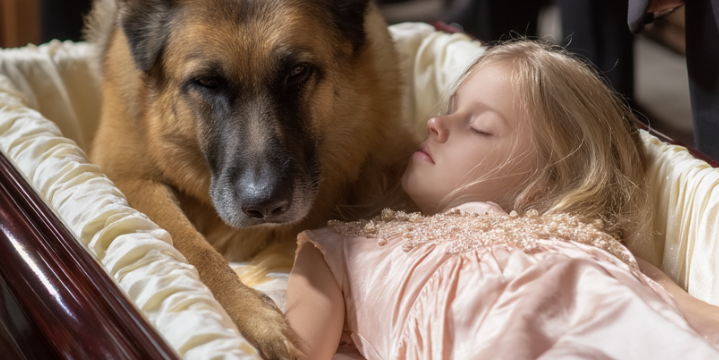It began as an ordinary day in the peaceful neighborhoods of Florida, where the boundaries between wilderness and suburb often blur. Residents are no strangers to the occasional wild visitor — a deer grazing in the yard, a raccoon scavenging through trash cans, or even the rare black bear searching for food. But what happened that day would become one of the most astonishing displays of courage and compassion ever witnessed. It all started when a massive 400-pound black bear wandered too close to a residential area, setting off a chain of events that no one could have predicted.

Wildlife officials were called to the scene to ensure the safety of both the residents and the animal. Their plan was straightforward — sedate the bear with a tranquilizer dart and then relocate it to a safer, natural environment deep in the forest. Everything went as expected at first. The officers took careful aim, fired the dart, and watched as it struck the bear successfully. But instead of calming down, the animal reacted in panic. The sting of the tranquilizer triggered its fight-or-flight response, and in its confusion and fear, the enormous creature bolted — not toward the woods, but straight toward the ocean.
Witnesses watched in shock as the black bear charged across the sand and plunged into the surf. The officers yelled and scrambled to stop it, but it was too late. The sedative began to take effect almost immediately, and the powerful beast that moments earlier had bounded with raw strength now struggled to stay afloat. Within minutes, the bear’s movements grew sluggish, its massive body beginning to sink beneath the waves. That’s when one man made a decision that would define the meaning of bravery.
Adam Warwick, a biologist with the Florida Fish and Wildlife Conservation Commission, saw the desperate situation unfolding before him. Without hesitation, he kicked off his shoes, stripped off his gear, and dove into the ocean. “It was a spur-of-the-moment decision,” Adam later recalled. “I had a lot of adrenaline pumping when I saw the bear in the water.” He knew full well the danger he was putting himself in — a 400-pound bear, even sedated, could lash out unpredictably. A single swipe from its claws could have caused serious injury or worse. But in that instant, instinct overpowered fear. Adam’s only focus was saving the drowning animal.
The waves were rough, and the bear, dazed and confused, thrashed weakly as it tried to stay above the surface. Adam swam toward it, carefully gauging its movements. “I knew I had to be cautious,” he said. “Even though it was sedated, there was still a risk it could come to for a moment and see me as a threat.” Despite the uncertainty, he continued until he was close enough to reach the bear. The animal’s head began to dip underwater, its breathing shallow. Acting quickly, Adam wrapped one arm around the bear’s neck and steadied its body with the other.
It was a sight that left onlookers speechless — a man holding up a 400-pound black bear in the ocean, kicking and struggling to keep them both afloat. The current was strong, and the weight of the animal made swimming nearly impossible. For every stroke Adam took, the bear seemed to drag him back a few inches. But he refused to give up. “There was no time to think about how hard it was,” he explained later. “All I could think about was keeping that bear’s head above water.”
For what felt like an eternity, Adam fought against the tide, guiding the bear closer to shore. His muscles burned, his lungs screamed for air, but he pressed on. Wildlife officers and bystanders watched anxiously from the beach, some shouting words of encouragement while others prepared to assist as soon as he reached shallow water. Finally, after what seemed like a lifetime, Adam’s feet touched the sandy bottom. With sheer determination, he half-carried, half-dragged the bear toward the shoreline.
When they finally reached land, exhausted but alive, the crowd erupted in relief. The bear lay on the sand, breathing heavily but stable. Officers quickly surrounded the animal, ensuring it remained calm and safe while the sedative wore off. Adam, drenched and trembling, stood nearby — his arms scratched, his body covered in saltwater and sand, but his eyes filled with quiet satisfaction. “I was just glad it was over,” he said. “I didn’t want to see that bear drown.”
The bear was later safely transported back to its natural habitat, far from residential areas, where it could roam freely once more. Officials credited Adam’s quick thinking and courage for saving the animal’s life. “It was a risky move,” one colleague admitted. “He could have been seriously hurt. But thanks to his actions, the bear survived and was returned home safely.”
News of the rescue spread quickly, capturing hearts across the nation. Photos of Adam carrying the bear through the water circulated online, earning him widespread praise as a real-life hero. Social media users flooded comment sections with messages of admiration. “Not all heroes wear capes,” one post read, echoing the sentiment shared by thousands. Another wrote, “In a world that often feels cold, this reminds us there’s still kindness and courage out there.”
But for Adam, the recognition was never the goal. “I didn’t do it for attention,” he said humbly. “I just couldn’t stand by and watch a helpless animal die.” His act of compassion became a powerful reminder of the connection between humans and nature — a relationship that demands respect, understanding, and sometimes, selfless courage.
Experts later noted that while tranquilization is standard practice in wildlife relocation, unpredictable reactions can occur, particularly when large animals are frightened or disoriented. The incident led to renewed discussions among wildlife officials about improving safety measures and response strategies in future rescues.
In the end, what could have been a tragic story became one of hope and heroism. The image of a man and a bear struggling together against the tide symbolized something profound — the extraordinary lengths humans can go to when empathy outweighs fear. Adam Warwick’s courage proved that sometimes, the most heroic acts are those that happen without planning or fanfare, driven purely by instinct and compassion.
The black bear returned safely to its forest home, unaware of how close it had come to tragedy or the human who risked everything to save it. But for those who witnessed that day, the memory endures as a testament to bravery — and a gentle reminder that every life, whether human or animal, is worth saving.





